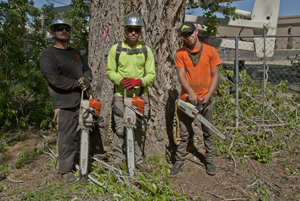spend the morning with Sally Jane, checking out some of the exhibitions including a personal walk-through of the Animalia project with producers Angela Main and Caroline McCaw (more kiwis!). then on to the ART MUSEUM to see THE SHOW curated by Steve Deitz. some amazing works, leading off with the elegant live-chat-based piece.
lunch with Ken at La Victoria Taqueria, better burritos than Macho Taco which was inexplicably closed at lunch-time.
also happen upon the npr (neighborhood public radio) broadcast studio at the downtown cineplex in an unused ticket booth. was wondering where they were broadcasting from — last night I happened to tune them in at 88.9 on the car radio on the commute back to the ‘burbs. so, met Jon Brumit and
hard to begin and end the day with a rattling vibrating swervy commute that lasts about an hour, door-to-door.
some overviews on the conference:
yadda-yadda-yadda; blah-blah-blah.
so many words, so many moving images, so much sound, talking heads, and spectacle. along with nice personal encounters. the monumental, the hierarchic voices along with the personal, networked, and confidential/private.
San Jose is interesting clash of urban-renewal towers of glass and corrosion-resistant metals: ringed some hard-core barrio Victorian bungalow scene, interlaced with the chronic homeless scattered between the shining spaces and conventioneers.
organized networks are interested in new institutional forms. tactical media has come to a stage of confronting itself. question of scalar transformation, (vs) networked organizations. democracy and networks are antithetical. bunk.
prototypes: sarai, iDC, srishdi school of art and media, indy media, etc

end up going to see a Mike Figgis remix of his film Time Code. a pseudo-press guy is giving away a couple tickets, so I snag one. he explains that he’s not really press, but a writer, and is trying to write a history of media art starting with the worldview of Gertrude Stein. I didn’t quite understand what he was trying to tell me. I suppose he very well might be a better writer that explainer. the film is a disappointment — the subject of the narrative is hermetically sealed in Hollywood and lacks any compelling visual or story elements. Mike is there, verily, and does a live “remix” which consists of rewinding the tape(!) and fading in/out the 4 different screen audio tracks. in form — the four frames which simultaneously inhabit the main screen that were recorded in four single simultaneous takes starting at the same time — there is an extremely interesting potential, especially as the overall resolution of video systems for shooting, recording, editing, and playback are gradually increasing. but the possibilities of the form seem completely wasted by the insipid narrative and visual void. is it a joke maybe?
head back to Livermore on the 87-280-680-84 pilgrimage route. not really liking that violent traverse of the land. though one segment moves across the Calaveras Valley which is still unpopulated and sports the rolling amber hills with huge live oaks scattered at stellar intervals.







